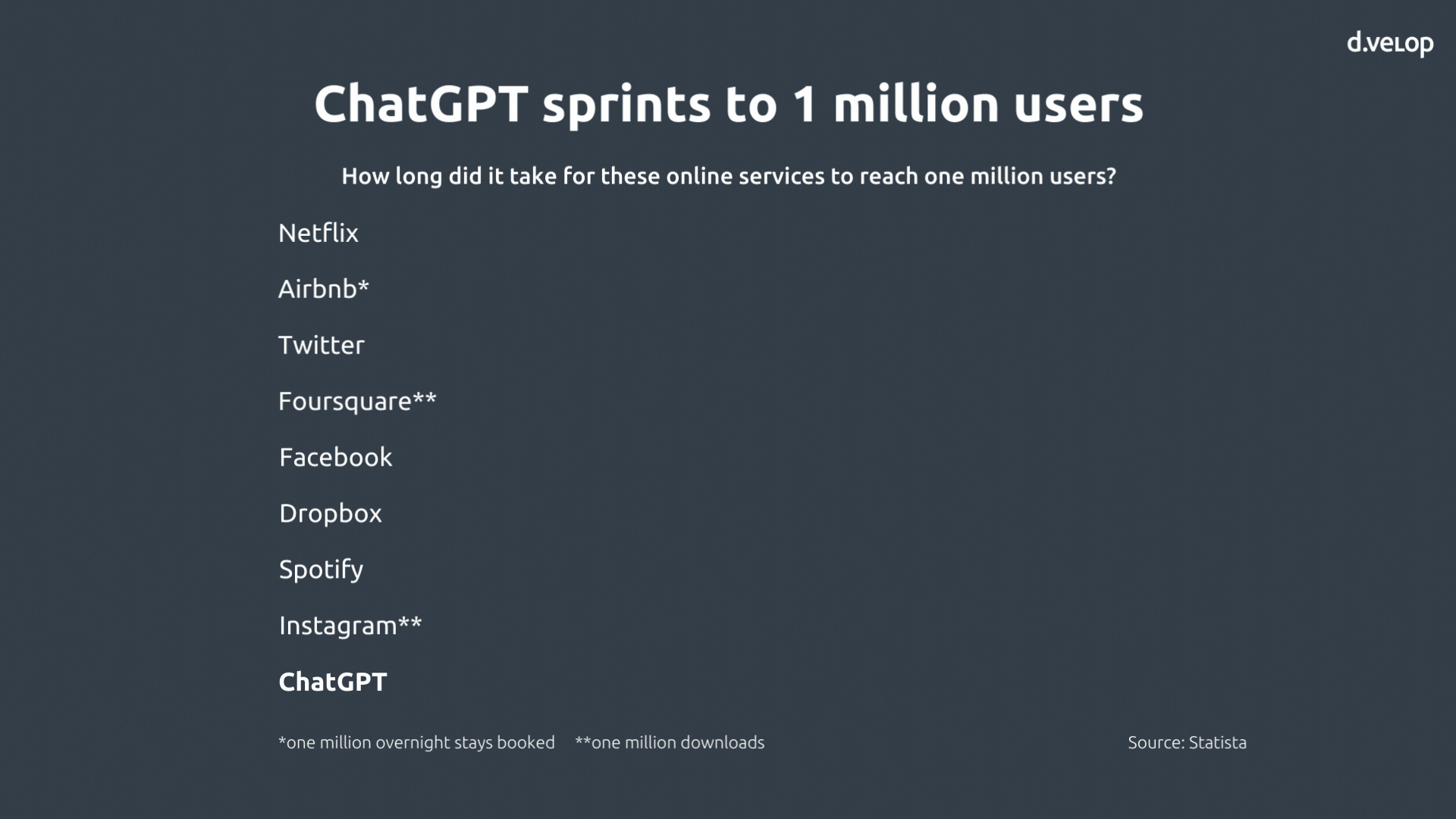The path to innovation is often unpredictable. As Steve Jobs aptly said:
You can’t connect the dots looking forward; you can only connect them looking backwards.
Steve Jobs
He emphasised that it is only in hindsight that we recognise how ideas have grown into successful innovations.
The availability of new technologies is fuelling innovation
This idea can be applied particularly well to the availability of new technologies and their impact on innovation. Today, we are experiencing a fascinating development in the field of new technologies. Innovations are spreading at breakneck speed. A good example of this is Netflix, which took five years to reach the one million user mark. In contrast, ChatGPT reached this figure in just five days.

Source: Statista
This illustrates how quickly new technologies spread and how they can change our lives.
Application examples of large language models and AI at d.velop
In addition to ChatGPT, numerous other generative AI models have been published in recent months. At d.velop, we are currently working intensively on how we can combine artificial intelligence technologies that have been available for several years with large language models and our existing products.
The d.velop pilot: Interacting with documents through LLM & AI
As a result, there is a new button in various places on our platform to get support from AI in your day-to-day work. We call this new functionality d.velop pilot.
The d.velop pilot extends d.velop documents with the option of importing and interacting with documents in an intelligent way. The app uses the latest artificial intelligence techniques for this purpose. Input in the form of natural language queries is interpreted using large language models and translated into actions. This makes it even easier and more effective for d.velop users to work with their documents in future, saving them time in the process.
Definition of Large Language Model (LLM)
A Large Language Model (LLM) is a large pre-trained language model based on neural networks with transformer architecture and deep learning algorithms. It is pre-trained with huge amounts of text and fine-tuned for specific tasks.
Large language models (LLMs) understand, process and generate natural language and can be used for many tasks such as answering questions, summarising texts, completing texts, translating texts or generating texts. LLMs can also deal with complex texts, questions or instructions and generate grammatically and orthographically correct, coherent texts.
Use of the d.velop pilot via chat in d.velop documents
An application scenario: The use of the d.velop pilot via chat. You can easily
- get a summary of a document or
- ask specific questions about the document.
Location-independent use via speech-to-text and text-to-speech
Another application example of the combination is new ways for users to interact with d.velop software using speech.
Never go into a meeting unprepared again, despite traffic jams
Imagine you’re in the car on the way to work and you realise that a certain document forms the basis for the first meeting of the day. Unfortunately, you haven’t read the document yet and there are only a few minutes left before the meeting starts due to a traffic jam. No problem! With the help of the d.velop pilot, you can simply have a summary of the document read out to you.
Test d.velop pilot without obligation 🚀
From now on you can try out the d.velop pilot yourself for test purposes. The first features of d.velop pilot are now available in the d.velop cloud!
The use of large language models and European values are not mutually exclusive
Of course, innovations such as large language models also raise questions about data security. In the current dynamic surrounding AI innovations, there are many unanswered questions, such as the regulation of AI, ensuring data control and ethical aspects. Nevertheless, it is important that we look at the possibilities of large language models now and at the same time develop ideas on how we can use them in line with European values. Working with models based on natural language enables rapid accessibility to artificial intelligence and represents a turning point for the software industry.
At d.velop, we recognise the importance of these developments, which is why we are keeping open the possibility of working with strong partners to further advance the various aspects of AI technology.
Cooperation with Aleph Alpha
We are particularly pleased that we can integrate the German company Aleph Alpha and their powerful Large Language Model Luminous into d.velop documents. Aleph Alpha is well known for the use of GPTs and Large Language Models in Europe.
The future of innovation lies in the combination of technology and human creativity
The future of innovation lies in the combination of technology and human creativity. The d.velop pilot is a step in this direction and enables us to explore the potential of large language models and utilise them in our everyday work. We look forward to further exciting developments to discover the possibilities of AI!
